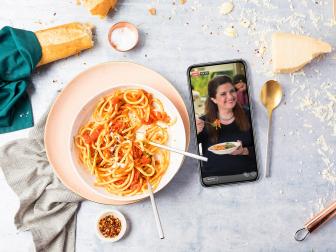These 4 Hacks for Cutting Vegetables Change Everything
Surprise, you've probably been cutting these common veggies all wrong.


Get a Premium Subscription to the Food Network Kitchen App
Download Food Network Kitchen to sign up and get access to live and on-demand cooking classes, in-app grocery ordering, meal planning, an organized place to save all your recipes and much more.
In this series, we're showing off some of the coolest recipes, tips and tricks we've learned from chefs in the all-new Food Network Kitchen app.
I’m always trying to pack more vegetables into my diet, but cutting up a bunch of them up can be messy and time-consuming. Yes, I did go to culinary school, and yes, I’m still of this opinion. Take the bell pepper: it scatters seeds all over the cutting board. Or the avocado: why is it unpredictably so darn hard to peel? But thanks to the new Food Network Kitchen app, I’ve garnered several brilliant new ways to cut up vegetables that even culinary school didn’t teach me.
1. A Neater Way to De-Seed Bell Peppers
During chef Elena Besser’s class, How to Upgrade Store-Bought Hummus (pictured above) she demonstrates how to cut a bell pepper in a matter of seconds without getting any seeds on the cutting board. "Cut off the top. Cut off the bottom," she instructs, as she slices each end flat. "Run your knife right down it, turning the pepper vertically as you run your knife across the sides," she says, as she rotates the knife around the inside of the pepper. Then there’s the aha moment: Elena pulls out the core of the pepper in one swift movement, removing all of the seeds. “And look at that. Where are the seeds? They are all in the center. They are nowhere on our cutting board!”

Lauren Volo
2. The Correct Way to Cut Broccoli Florets
It’s unsurprising that cookbook author Raquel Pelzel, who’s written veggie-heavy cookbooks like Sheet Pan Suppers Meatless, has a smart trick or two about slicing and dicing vegetables. During her Umami-Roasted Vegetables class, she reveals that we’ve all probably been cutting broccoli wrong. Here’s what we should do. First, cut off the stalk, trim off its skin with your chef’s knife, and slice the center into bite-size pieces. "The center part of the broccoli is like a broccoli heart – it’s really tender and too good to throw away," Pelzel says. Next, place the broccoli crown-side down on the cutting board, and slice off the florets as you rotate the stalk. "When you get to the end, you have your little broccoli florets and you can cut them really easily upside down too," she explains.

3. The Trick to Peeling Avocados
Okay, technically an avocado is a fruit, but Jeff Mauro’s avocado peeling trick is too good to pass up. During his Chicken Cobb Sandwich class, he gives halves an avocado and then bestows his wisdom: "What you want to do is lop just a little bit off the small end [of the avocado half] so you have an easier place to start peeling – without having to bruise or disrupt that very tender fruit." This knife cut creates corners; grasp onto a corner of the skin and peel it right off in one big piece.

Rob Pryce
4. How to Shred Cabbage (No Food Processor Required)
Slaws and salads often call for thinly sliced or shredded cabbage. Thickly sliced raw cabbage is tough. It’ll give your jaw a workout, and no one wants that. But hauling out the food processor is a pain, and tackling a whole head with a chef’s knife can be intimidating. Luckily, Food Network Culinary Producer Ali Clarke teaches us an approachable way to slice cabbage paper-thin during her Cajun Cabbage Skillet class. First, she says that most recipes don’t call for a whole head — so she likes to halve the cabbage and only slice the part she needs. Leftover cabbage keeps better un-sliced — plus, you make less work for yourself so you can focus on calm, neat slicing. Second — and this is the really smart part — turn the cabbage as you cut it to make sure a flat surface is always touching the cutting board. "We started with something round and rolly," Ali says. "Once you halve it, turn it onto the flat side to slice and cut it into strips. Once you get to the point where the piece you’re cutting is small and feels unstable, turn it over to find another flat surface."
Related Links:























